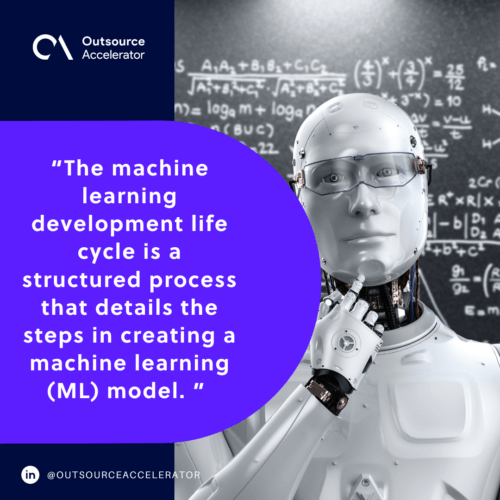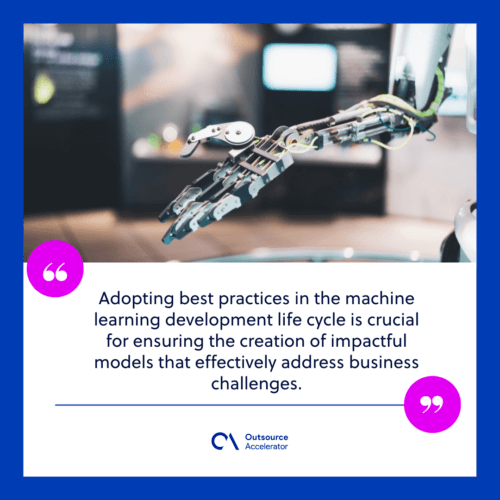Your 6-step guide to the machine learning development life cycle

Machine learning has revolutionized various industries by enabling systems to analyze and interpret massive amounts of data at an unparalleled rate.
However, successfully developing and deploying a machine learning model requires a structured approach.
How do tech companies do it? It’s all explained in a process known as the machine learning development life cycle.
In this article, we’ll take you through the six steps of the machine learning development life cycle. It’s through these steps that tech firms are able to design and release solutions and applications for their clients in different industry sectors.
Overview of the machine learning development life cycle
The machine learning development life cycle is a structured process that details the steps in creating a machine learning (ML) model.
Each stage in the life cycle is interconnected and iterative. This feature allows for continuous improvement and refinement of the machine-learning solution.
This systematic approach ensures that ML projects are well-planned, executed efficiently, and result in robust and effective models.

6 Steps of the machine learning development life cycle
The six steps of the machine learning development life cycle are as follows:
Step #1: Problem definition
At this initial stage, the focus is on understanding the business problem or objective that the machine learning model aims to address.
It involves:
- Collaborating with stakeholders to defiance clear and achievable goals
- Identifying key performance indicators
- Understanding the constraints and requirements of the project
This step is crucial as it sets the direction for the rest of the machine learning development process.
Step #2: Data collection and preparation
This step involves gathering the relevant data required to train and validate the machine learning model. The data may come from various sources, including databases, APIs, or external datasets.
Developers must ensure that the collected data is representative and of sufficient quality for training the model. The data is then processed and prepared for training.
This may involve:
- Data cleansing
- Handling missing values
- Performing feature engineering
- Data transformation into a suitable format
Step #3: Model selection
Different machine learning algorithms are explored and evaluated to determine the most suitable one for the given problem.
Different factors influence the choice of algorithm, including the following:
- Nature of the data
- The complexity of the problem
- Available computational resources
Evaluation metrics are then used to compare and select the best-performing model.
Step #4: Model training
Once the model is selected, it is trained on the prepared data to learn patterns and relationships.
The data is typically split into training and testing data sets. The model is trained on the training set and evaluated on the testing set to assess its performance (which occurs in the next step).
During training, hyperparameters may be tuned to optimize the model’s performance. Techniques like cross-validation may be used to ensure robustness.
Step #5: Model evaluation
This step of the machine learning development life cycle has the model evaluated after training. This stage assesses its generalization ability and performance in real-world scenarios.
The model is tested on a separate validation dataset or with cross-validation techniques. The aim is to ensure that the model generalizes well to unseen data.
Evaluation metrics are calculated based on the model’s predictions and compared against the ground truth to measure its effectiveness. Developers can then identify areas for improvement and make deployment decisions.
Step #6: Model deployment and monitoring
The final step of the machine learning development life cycle involves deploying the trained and evaluated model.
It is placed into a production environment where it can be used to make predictions on new, unseen data.
This stage also involves building a pipeline for retraining the model with new data and implementing mechanisms for monitoring.
Continuous monitoring is essential to ensure consistent performance. Feedback loops may be established to collect data, enabling improvements and updates to the model.
Adopting best practices for the machine learning development life cycle
Adopting best practices in the machine learning development life cycle is crucial for ensuring the creation of impactful models that effectively address business challenges.

Here are some best practices to consider:
Understand data sources
Quality data forms the foundation of successful machine learning models. You must thoroughly understand the data sources available and ensure that the data is relevant, accurate, and representative of the problem domain.
Ensure reproducibility
Document all preprocessing steps, model configurations, and hyperparameters used during development to ensure reproducibility.
This helps track changes, debug errors, and share insights with stakeholders.
Address bias and fairness
Be aware of biases present in the data and model and take steps to address them. Consider fairness, diversity, and ethical implications when designing and deploying machine learning models.
Collaborate and seek feedback
A successful run of the machine learning development life cycle often requires collaboration between data scientists, domain experts, engineers, and business stakeholders.
Seeking feedback, validation, and insights from diverse perspectives will improve the model’s effectiveness.
Adopt an iterative approach
Machine learning development is inherently iterative. Based on feedback and performance evaluations, be prepared to revisit and refine each step.
This also means regularly updating and retraining the model with new data.
An iterative process helps continuously improve the model and adapt it to new insights or changing requirements.
Adhering to these steps and best practices will help you systematically add true value to machine learning projects.







 Independent
Independent




